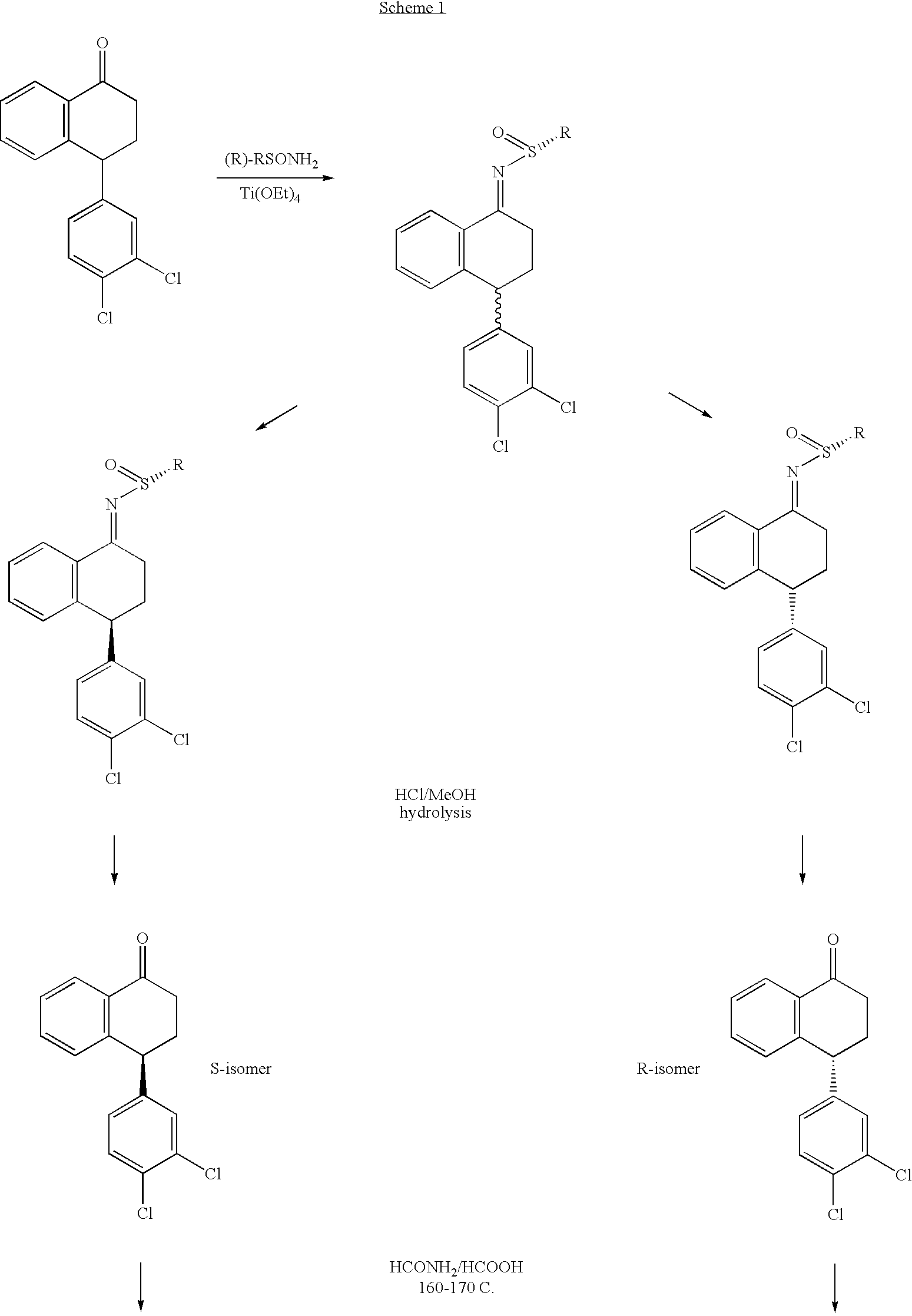Combinations of Eszopiclone and Trans 4-(3,4-Dichlorophenyl)-1,2,3,4-Tetrahydro-N-Methyl-1-Napthalenamine or Trans 4-(3,4-Dichlorophenyl)-1,2,3,4-Tetrahydro-1-Napthalenamine, and Methods of Treatment of Menopause and Mood, Anxiety, and Cognitive Disorders
a technology of eszopiclone and n-methyl-1, which is applied in the field of compositions and methods for the treatment of menopause and mood, anxiety, and cognitive disorders, can solve the problems of affecting the quality of life, so as to increase the effect of antidepressant therapy
- Summary
- Abstract
- Description
- Claims
- Application Information
AI Technical Summary
Benefits of technology
Problems solved by technology
Method used
Image
Examples
example 1
Formulations
[0143]The following formulations are exemplary of eszopiclone and trans 4-(3,4-dichlorophenyl)-1,2,3,4-tetrahydro-N-methyl-1-napthalenamine or trans 4-(3,4-dichlorophenyl)-1,2,3,4-tetrahydro-1-napthalenamine combination tablet or capsule formulations:
TABLE 1Eszopiclone and trans 4-(3,4-dichlorophenyl)-1,2,3,4-tetrahydro-N-methyl-1-napthalenamine compositionsCombo Strengths(Eszopiclone / trans 4-(3,4-dichlorophenyl)-1,2,3,4-tetrahydro-N-methyl-1-Ingredientnapthalenamine, mg / unit)(Tablet and Capsule)3.0 / 25.03.0 / 50.03.0 / 100.0Eszopiclone3.003.003.00trans 4-(3,4-dichlorophenyl)-1,2,3,4-28.0056.00112.00tetrahydro-N-methyl-1-napthalenamine HCl1Microcrystalline Cellulose, NF (Avicel ®198.90198.90198.90PH102)Dibasic Calcium Phosphate Anhydrous90.0090.0090.00USPCroscarmellose Sodium, NF6.006.006.00Colloidal Silicon Dioxide, NF0.600.600.60Magnesium Stearate, NF1.501.501.50Total tablet wt. or capsule fill wt.328.00356.00412.00Empty Size 0 hard gelatin capsule wt.90.0090.0090.00Total w...
example 2
Clinical Study on Treatment of Menopause or Perimenopause with Eszopiclone
[0157]The study was aimed at observing efficacy of eszopiclone 3 mg compared to placebo in the treatment of insomnia secondary to perimenopause or menopause.
[0158]The study was a multicenter, randomized, double-blind, placebo-controlled, parallel-group study. The study had a one-week single-blind placebo run-in period, followed by four weeks of double blind treatment, and one week of single blind placebo wash-out. The primary method of analysis compared the post-randomization results between the two treatment groups.
[0159]Subjects were women with insomnia secondary to perimenopause or menopause. Subjects were perimenopausal or menopausal and had insomnia symptoms including ≧45 minutes sleep latency (SL) and total sleep time (TST) ≦6 hours. Perimenopausal / menopausal symptoms predated the onset of sleep disturbance symptoms. The patient population was predominately Caucasian (77.2%). The mean age was 49, with a ...
example 3
trans 4-(3,4-dichlorophenyl)-1,2,3,4-tetrahydro-N-methyl-1-napthalenamine Activity Assays
Experimental Conditions for Monoamine Uptake Assays
Serotonin Functional Uptake Assay
[0164]Characterization of serotonin uptake is performed using synaptosomes isolated in a 0.32 M sucrose buffer from a male Wistar rat cortex. The uptake of radiolabelled serotonin by synaptosomes (100 μg of proteins / point) is allowed by incubating them in a deep well for 15 minutes at 37° C. in presence of test compounds and [3H]5-hydroxytryptamin (0.1 μCi / point).
[0165]Synaptosomes and [3H]5-hydroxytryptamine are prepared in a Krebs buffer pH 7.4 containing 25 mM NaHCO3, 11 mM glucose and 50 μM ascorbic acid. This incubation buffer is oxygenated during 5 minutes before incubation. Basal control is incubated for 15 minutes at 4° C. in order to avoid any uptake. Following this incubation the uptake is stopped by filtration through an “unifilter 96-wells GFB” Packard plate washed with Krebs buffer containing 25 mM N...
PUM
| Property | Measurement | Unit |
|---|---|---|
| pressure | aaaaa | aaaaa |
| optical purity | aaaaa | aaaaa |
| optical purity | aaaaa | aaaaa |
Abstract
Description
Claims
Application Information
 Login to View More
Login to View More - R&D
- Intellectual Property
- Life Sciences
- Materials
- Tech Scout
- Unparalleled Data Quality
- Higher Quality Content
- 60% Fewer Hallucinations
Browse by: Latest US Patents, China's latest patents, Technical Efficacy Thesaurus, Application Domain, Technology Topic, Popular Technical Reports.
© 2025 PatSnap. All rights reserved.Legal|Privacy policy|Modern Slavery Act Transparency Statement|Sitemap|About US| Contact US: help@patsnap.com



